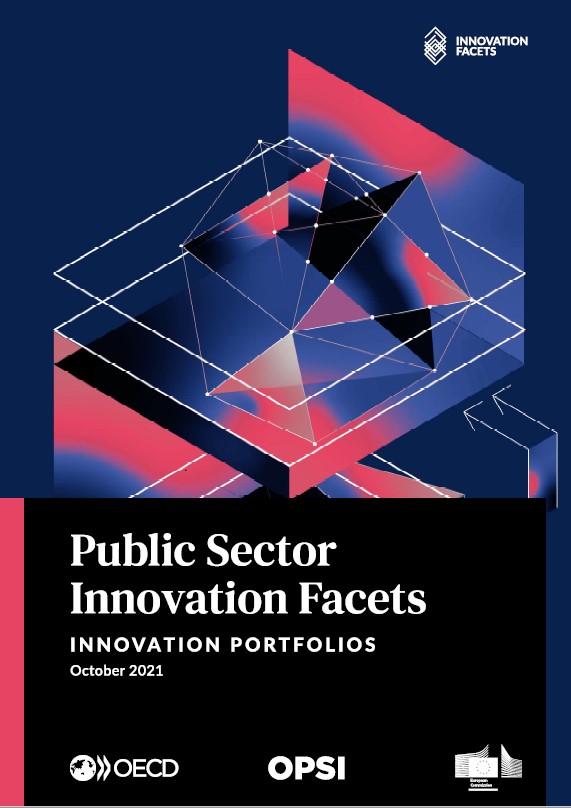Public Sector Innovation Facets: Innovation portfolios

What is a portfolio approach to innovation?
The innovation portfolio approach is a way to manage the various innovation facets (e.g. mission-oriented, adaptive, enhancement-oriented and anticipatory innovation facets). It supports public sector organisations to balance innovation efforts and enhance knowledge creation and sense-making, mapping portfolio activities and identifying possible synergies. In addition, it ensures agility across different activities, facilitates risk assessments across the portfolio, measures and evaluates the innovation process, and ensures effective activity co-ordination across the portfolio.
The main benefits of innovation portfolios are therefore:
- Avoiding fragmentation and projectification
- Tackling risk aversion and learning on the portfolio level
- Finding synergies between projects and activities
- Building value chains between different project areas
- Keeping tabs on layered activities connected to big reforms
- Planning across ecosystems
- Avoiding lock-in and capture by innovation fads and fashions

Relational sense-making in Finland
Sitra is Finland’s public innovation fund. It operates both as a think tank and as an investment company. It employs approximately 180 people and works on diverse topics such as climate change, data, democracy and the circular economy. Sitra has adopted an innovation portfolio approach to systematise and develop their capacities for renewal. Sitra’s portfolios include a list of strategic goals and user interviews which aim to understand the broader context and relevance of the innovation projects. These goals and interviews help to highlight the main “pain points” and, thus, the most desired outcomes from innovation work.
???????? Finland
Which lessons can be applied from the private sector and which cannot?
Portfolio management methods were first applied in the financial sector with a view to steering investment decision-making. In the private sector, assessing alternatives in portfolios is commonly associated with evaluating investment options and relies on a number of models which aim to help organisations make innovation investment decisions based on a variety of criteria. These models, however, tend to bias the portfolio towards investment and financial value logic and means that in large organisations exploitation activities tend to be favoured over exploration. Consequently, many of these models have been critiqued due their biases and blind spots.
In the public sector, not all innovation efforts are driven by financial returns and have a single organisational competitive advantage perspective. Public sector success criteria are varied and frequently qualitative in nature, while innovation impacts have longer time spans than in the private sector. Hence, some of the above-described functions and models may not be applicable in the public sector and require broader approaches.
Functions of portfolio management
Creating new knowledge and space for sense making: spreading organisational assets across a diverse spectrum of activities will enable the development of mechanisms to create intelligence through practice and collaboration.

Climate KIC
Climate KIC is a Knowledge and Innovation Community (KIC) co-funded by the European Union to identify and support types of innovation specifically designed to mitigate and adapt to climate change. Climate KIC is also involved with the “Transition Cities” project through which eight European cities have formed thematic clusters around the topics of energy networks, mobility and buildings. The key motivation for the use of an innovation portfolio approach in Climate KIC was the need to understand, map and visualise the activities of the innovation system. The main elements in this exercise were governance structure, and the skills and types of activities in the cities. A mapping exercise and the formulation of a portfolio served as the starting point for discussing and creating alignment around a common vision. The need for such a common vision is especially relevant in a context where various organisations respond to the need of different funding calls, and creates an opportunity to develop an action plan. In this case, a portfolio overview enabled project managers to adopt an ecosystems perspective when conceptualising problems and possible strategies for action.
Mapping innovation portfolios to create a holistic view: innovation portfolio managers need to monitor and map innovation activities so that decision-making processes can be made holistically. In doing so, organisations or systems can swiftly shift resources such as investment, talent and leadership to more promising opportunities in quickly changing contexts.
Create a diverse supply of innovation: innovation often involves risk and uncertainty. To develop a risk readiness in the portfolio, organisations and systems must create a diverse supply and sufficient allocation of budget, technology, human resources and knowledge across different innovation activities.
Measure and evaluate the status of the innovation process: It is important to evaluate the success of innovation portfolio implementation, taking into consideration the type of innovation, the expected accomplishments and lessons learnt. While this is a notoriously difficult task, the report highlights some key questions that innovation portfolio managers can ask to track, measure and evaluate their innovation portfolios.

Portfolio learning in Chicago, United States
The Office of Innovation forms part of the city of Chicago and has been assigned the role of a “fixer” when problems arise in departmental innovation processes. The impetus for using innovation portfolios stemmed from the realisation that innovation teams themselves did not possess a mandate to innovate, largely because public sector innovation was not perceived as either possible or legitimate. The Office of Innovation was created to centralise innovation assistance and to introduce relevant performance metrics. A second motivation for the creation of the group was to enable greater continuity of projects in the city by fostering institutional memory and continuity, regardless of changes in the political administration. To this end, the Office of Innovation has created a database of innovation projects, which tracks ideas, progress and failures, and provides a systemic overview of innovation progress. This approach has also encouraged a culture of learning and understanding failures as a normal aspect of innovation work.
???????? United States
Ensure efficient project co-ordination and portfolio stewardship: whereas innovation might arise from different units in an organisation or actors in a system, it is essential to maintain the interconnections between activities while balancing approaches derived from different decision makers. A dynamic decision-making process, setting clear objectives for different parts of the portfolio, owning decisions, facilitating learning across activities and identifying systemic patterns, among others, are therefore all important parts of the portfolio approach.
Tools and methods
Portfolio practices in the public sector can be supported through tools that are designed to illustrate the distribution of resources and activities, promote a better understanding of portfolio activities, and oversee complex innovation systems. However, in practice there is a notable lack of mature tools for developing innovation portfolios in the public sector. In particular, evaluation, measurement and benchmarking tools are needed. At present, tools tailored to risk management, resource allocation and understanding the underlying ecosystems connected to innovation portfolios are being trialled in the public sector following their usage in the private sector.
Main action points and takeaways
Innovation portfolio management is assuming an increasingly central role in the public sector. Managed or unmanaged, innovation portfolios already exist and their effectiveness to deliver on governments long-term goals is currently more ad hoc than intentional. Significantly more investment in research, testing and development of innovation portfolio approaches and models is needed as well as uptake in public sector organisations where practical lessons can be gleaned.
Innovation portfolio management performed well is a continuous activity that spans institutions. Innovation portfolios can be examined within and between units and teams, and across entire organisations. The key question is how to build synergies between these practices that translate into learning and decision making supportive of innovation across the whole organisation. Future research is needed on differentiated models of innovation stewardship and portfolio management, not only to fit different organisations but also to meet the needs of centres of government who are called to steer innovation for the public sector or an ecosystem as a whole.
This work received funding from the European Union‘s Horizon 2020 research and innovation programme under grant agreement No. 870913

Public Sector Innovation Facets: Innovation portfolios
Published on 27 October 2021.
